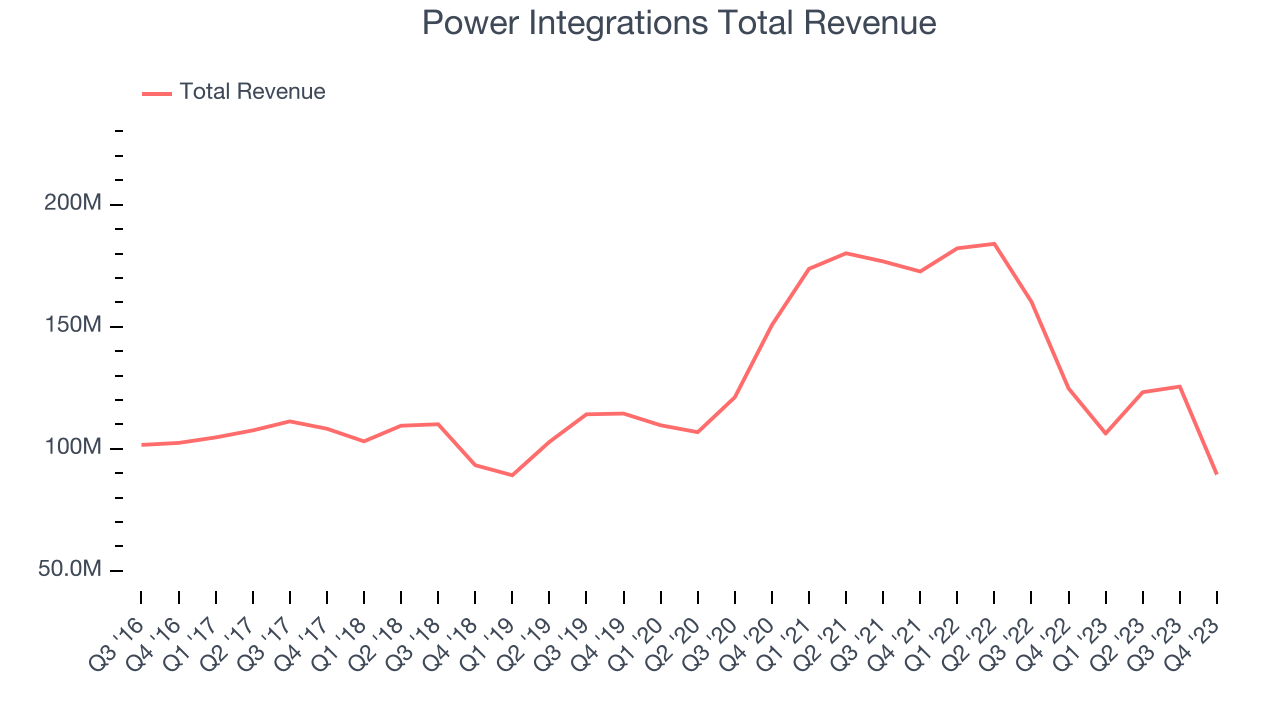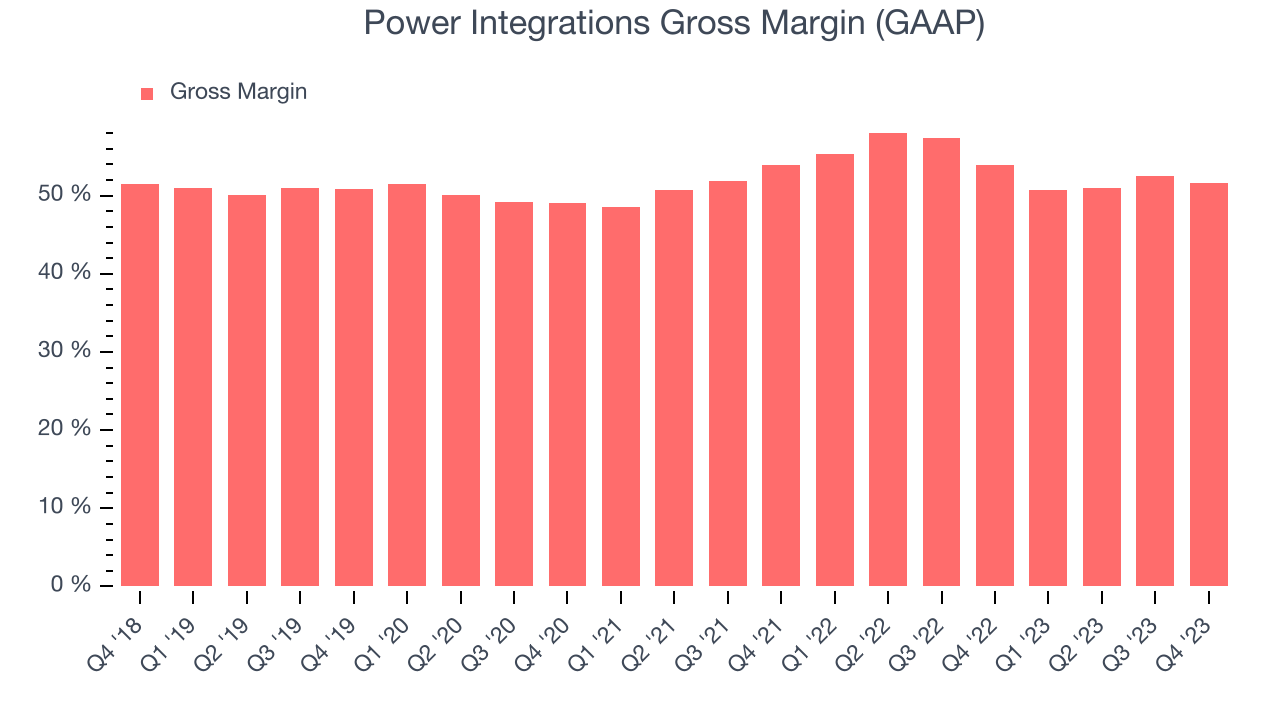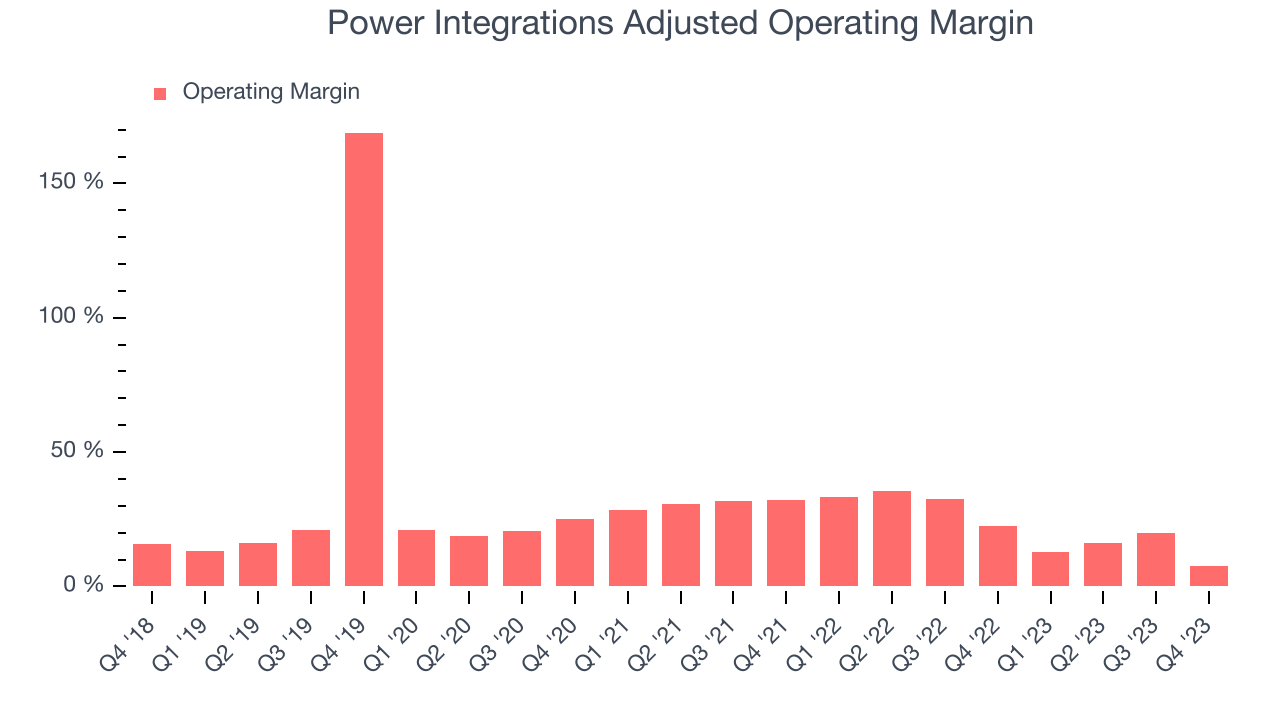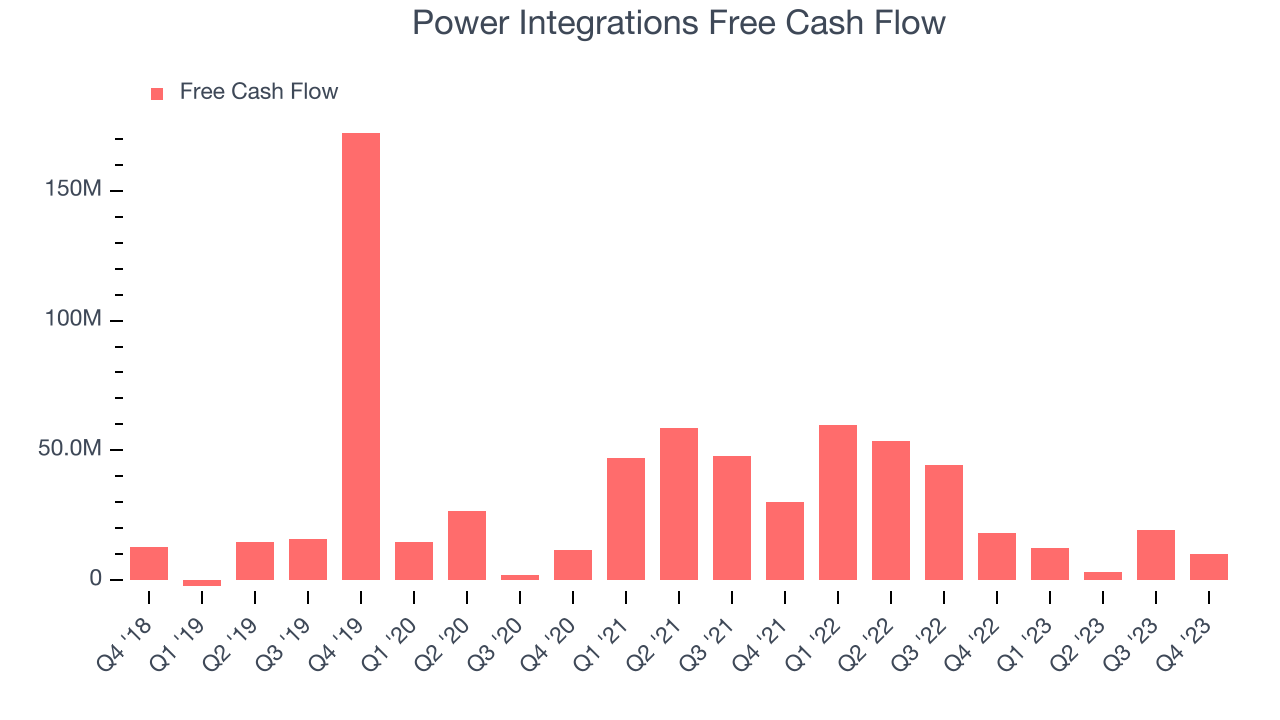Semiconductor designer Power Integrations (NASDAQ:POWI) fell short of analysts' expectations in Q4 FY2023, with revenue down 28.3% year on year to $89.51 million. Next quarter's revenue guidance of $90 million also underwhelmed, coming in 5.2% below analysts' estimates. It made a non-GAAP profit of $0.22 per share, down from its profit of $0.48 per share in the same quarter last year.
Power Integrations (POWI) Q4 FY2023 Highlights:
- Revenue: $89.51 million vs analyst estimates of $90.15 million (0.7% miss)
- EPS (non-GAAP): $0.22 vs analyst estimates of $0.15 (48.4% beat)
- Revenue Guidance for Q1 2024 is $90 million at the midpoint, below analyst estimates of $94.95 million
- Free Cash Flow of $10.12 million, down 47.3% from the previous quarter
- Inventory Days Outstanding: 343, up from 230 in the previous quarter
- Gross Margin (GAAP): 51.6%, down from 54% in the same quarter last year
- Market Capitalization: $4.31 billion
A leading supplier of parts for electronics such as home appliances, Power Integrations (NASDAQ:POWI) is a semiconductor designer and developer specializing in products used for high-voltage power conversion.
Power Integrations was founded in 1988 by Ray Orr and Steven Sharp. The company went public in December of 1997 and is currently headquartered in San Jose, California.
Almost all electronic devices that plug into a wall socket require a power supply to convert the high-voltage alternating current provided by electric utilities into the low-voltage direct current required by most electronic devices. POWI’s products address this need by converting alternating current (AC) to direct current (DC) or vice versa, reducing or increasing the voltage, and regulating the output voltage/current according to customer specifications.
POWI serves customers in four end-market groups: Consumer (e.g. manufacturers of home appliances, TVs), Communications (e.g. mobile phone chargers, adapters for routers), Industrial (e.g. motor controls, battery-powered tools), and Computer (smart home devices, wearables). POWI then contracts with three foundries for the manufacture of most of its silicon wafers.
Competitors in the market for high-voltage ICs include ON Semiconductor (NASDAQ:ON) STMicroelectronics (NYSE:STM), NXP Semiconductors (NASDAQ:NXPI), and Infineon.Sales Growth
Power Integrations's revenue growth over the last three years has been unimpressive, averaging 2.7% annually. This quarter, its revenue declined from $124.8 million in the same quarter last year to $89.51 million. Semiconductors are a cyclical industry, and long-term investors should be prepared for periods of high growth followed by periods of revenue contractions (which can sometimes offer opportune times to buy).

Power Integrations had a difficult quarter as revenue dropped 28.3% year on year, missing analysts' estimates by 0.7%. This could mean that the current downcycle is deepening.
Power Integrations may be headed for an upturn. Although the company is guiding for a year-on-year revenue decline of 15.3% next quarter, analysts are expecting revenue to grow 6.1% over the next 12 months.
Product Demand & Outstanding Inventory
Days Inventory Outstanding (DIO) is an important metric for chipmakers, as it reflects a business' capital intensity and the cyclical nature of semiconductor supply and demand. In a tight supply environment, inventories tend to be stable, allowing chipmakers to exert pricing power. Steadily increasing DIO can be a warning sign that demand is weak, and if inventories continue to rise, the company may have to downsize production.

This quarter, Power Integrations's DIO came in at 343, which is 177 days above its five-year average, suggesting that the company's inventory has grown to higher levels than we've seen in the past.
Pricing Power
In the semiconductor industry, a company's gross profit margin is a critical metric to track because it sheds light on its pricing power, complexity of products, and ability to procure raw materials, equipment, and labor. Power Integrations's gross profit margin, which shows how much money the company gets to keep after paying key materials, input, and manufacturing costs, came in at 51.6% in Q4, down 2.4 percentage points year on year.

Despite declining over the past year, Power Integrations still retains industry standard gross margins, averaging 51.5%, pointing to its competitive offering, decent cost controls, and possibly modest pricing pressure.
Profitability
Power Integrations reported an operating margin of 7.7% in Q4, down 14.7 percentage points year on year. Operating margins are one of the best measures of profitability because they tell us how much money a company takes home after manufacturing its products, marketing and selling them, and, importantly, keeping them relevant through research and development.

Power Integrations's operating margins have been trending down over the last year, averaging 14.2%. This is a bad sign for Power Integrations, whose margins are already below average for semiconductor companies. To its credit, however, the company's margins suggest modest pricing power and cost controls.
Earnings, Cash & Competitive Moat
Analysts covering Power Integrations expect earnings per share to grow 5% over the next 12 months, although estimates will likely change after earnings.
Although earnings are important, we believe cash is king because you can't use accounting profits to pay the bills. Power Integrations's free cash flow came in at $10.12 million in Q4, down 44.8% year on year.

As you can see above, Power Integrations produced free cash flow of just $44.88 million in the last year, resulting in a measly 10.2% free cash flow margin. Power Integrations will need to improve its free cash flow conversion if it wants to stay competitive.
Return on Invested Capital (ROIC)
EPS and free cash flow tell us whether a company was profitable while growing revenue. But was it capital-efficient? A company’s ROIC explains this by showing how much operating profit a company makes compared to how much money the business raised (debt and equity).
Although Power Integrations hasn't been the highest-quality company lately because of its poor top-line performance, it historically did a wonderful job investing in profitable business initiatives. Its five-year average ROIC was 44.4%, splendid for a semiconductor business.
The trend in its ROIC, however, is often what surprises the market and drives the stock price. Unfortunately, over the last two years, Power Integrations's ROIC has averaged a 7.6 percentage point decrease each year. We like the job Power Integrations's management has done historically but are concerned ROIC has declined recently, perhaps a symptom of waning business opportunities to invest profitably.
Key Takeaways from Power Integrations's Q4 Results
We were impressed by how significantly Power Integrations blew past analysts' EPS expectations this quarter. That stood out as a positive in these results. On the other hand, its revenue guidance for next quarter missed analysts' expectations and its operating margin shrunk. Overall, this was a mixed quarter for Power Integrations. The stock is flat after reporting and currently trades at $78.29 per share.
Is Now The Time?
When considering an investment in Power Integrations, investors should take into account its valuation and business qualities as well as what's happened in the latest quarter.
We cheer for everyone who's making the lives of others easier through technology, but in the case of Power Integrations, we'll be cheering from the sidelines. Its revenue growth has been weak over the last three years, and analysts expect growth to deteriorate from here. And while its stellar ROIC suggests it has been a well-run company historically, the downside is its operating margins reveal subpar cost controls compared to other semiconductor businesses. On top of that, its low free cash flow margins give it little breathing room.
Given its price-to-earnings ratio based on the next 12 months of 62.7x, Power Integrations is priced with expectations for long-term growth, and there's no doubt it's a bit of a market darling, at least for some. While we have no doubt one can find things to like about the company, we think there might be better opportunities in the market and at the moment don't see many reasons to get involved.
Wall Street analysts covering the company had a one-year price target of $82.03 per share right before these results (compared to the current share price of $78.29).
To get the best start with StockStory check out our most recent Stock picks, and then sign up to our earnings alerts by adding companies to your watchlist here. We typically have the quarterly earnings results analyzed within seconds of the data being released, and especially for the companies reporting pre-market, this often gives investors the chance to react to the results before the market has fully absorbed the information.
